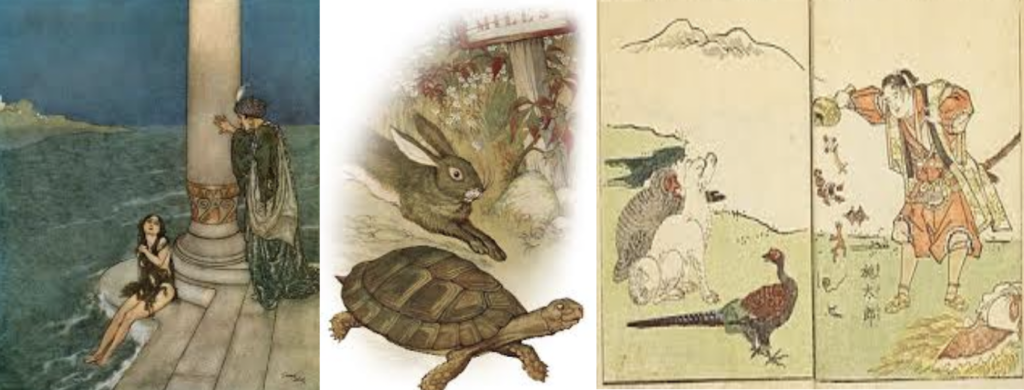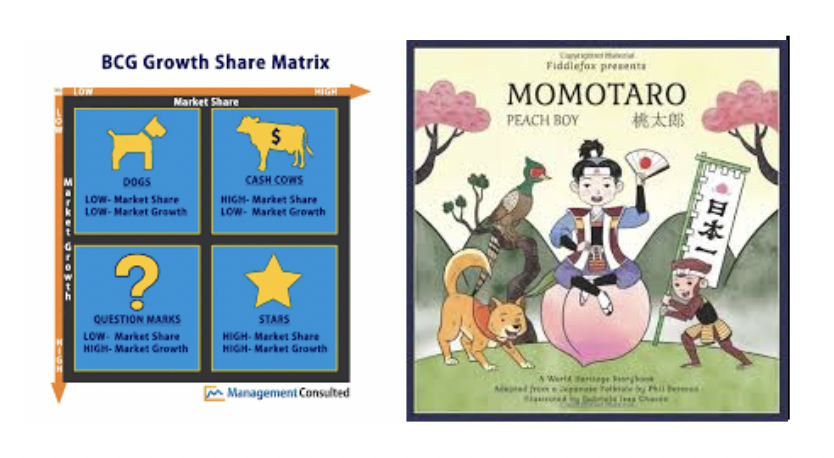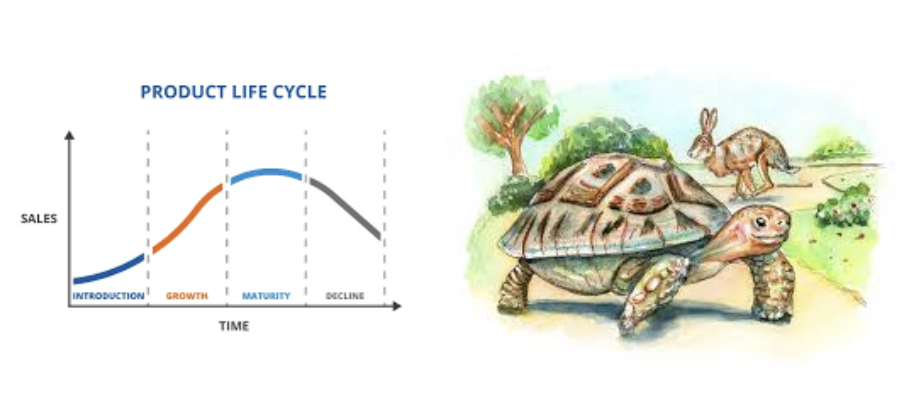
By Krish Tyagi
Our knowledge of storytelling, literature, cultural identity, art and human psychology has been greatly influenced by fairy tales. However, fairy tales have also shaped our understanding and perception of modern political and economic concepts, which has led to the development of numerous business theories and tools. This demonstrates the extent to which fairy tales have impacted multiple entrepreneurs mindsets, as evidenced by the business tools and theories that can be discovered concealed in stories like Momotaro, The Hare and the Tortoise and The Little Mermaid. Though there are many other ideologies and notions present in these fairy tales, I believe that the small exchange between the mermaid and the sea witch in The Little Mermaid by Hans Christian Andersen defines the crux of the barter system in economics. Using the concepts of friendship and sharing, Momotaro written by George Suyeoka deftly dissects the BCG Matrix model, a popular business tool. Meanwhile, The Hare and The Tortoise authored by Aesop uses its two central characters to physically illustrate how a product life cycle functions. Even though the connection between the business tool and fairy tale may not be immediately apparent without careful examination, it does have an effect on children’s perceptions, who are the intended audience, and it subtly registers all the business data that may help these kids develop sophisticated concepts about the future of entrepreneurship or macro and microeconomics. Moreover, The Hare and The Tortoise, The Little Mermaid and Momotaro explore business and economic concepts by utilising symbolism and imagery while helping children transition into more complex entrepreneurial ideas. These business concepts and entrepreneurial ideas also assist in introducing young children to analytical and critical thinking abilities.
- The Little Mermaid and The Barter System

The Little Mermaid explores the concept of the barter system in economics. The barter system relies on direct trading between people or entities based on their respective needs and offerings. It is a non-monetary means of exchanging commodities or services, which involves the negotiation of value between parties without the use of a defined means of exchange and predates the adoption of money. The very first instance that explored this concept was the initial trade off between the little mermaid and the sea witch regarding the witch’s magical potion in exchange for the mermaid’s voice. The little mermaid reaches out to the evil sea witch to assist her get legs instead of her tail in order to pursue her true love. The little mermaid already had to bear tons of hurdles to maintain her legs including the feeling of being sliced by sharp swords as her tail splits into legs, followed by the pain of knives piercing her legs as she walked. However, in addition, she was also faced with a legitimate formal trade off by the sea witch. The sea witch demanded her beautiful voice in exchange for her magical potion of obtaining legs. She emphasised the input equals to output system in business studies by demanding her lovely voice in return for her magical elixir that gave her legs. This demonstrates the basic fundamentals of a barter trade-off, specifically a direct barter exchange, in which two goods are directly traded in the absence of money. The voice and the potion symbolise business products in this situation. As the sea witch states “and it is no trifling price that I’m asking. You have the sweetest voice of anyone down here at the bottom of the sea, and while I …sharp as a two-edged sword.”(Andersen 293). Her choice of words helps create a sense of visual imagery as she refers to the mermaid’s voice as the most beautiful voice in the ocean, as if it’s a premium/luxury product. Since, the primary audience of the little mermaid are children, this trade-off creates a visual imagery in their minds, of two tangible products being exchanged.
Furthermore, this simple idea is briefly examined as the story proceeds, bringing up more complex ideas regarding the barter system. As the mermaid sets foot on land and extends her legs, the narrative inevitably takes a turn for the worse. The mermaid’s misery as a result of the trade is described in the story’s latter half. The young mermaid passes away and transforms into a sea creature as a result of the horrifying and brief description of her excruciating bodily suffering. This acts as proof for the unjust nature of their trade-off. In the end, the mermaid made more sacrifices than the sea witch. In comparison to the little mermaid who sacrificed her physical well-being and her entire family only to die, the sea witch just gave up a few drops of her blood for the potions. This fully captures the unfair and the sly deceitful characteristics of the barter system. Due to its inherent ambiguity and lack of a regulated value measuring method, the barter system in business can foster unfairness and deceit. Bartering parties may alter perceptions of value, take advantage of information imbalances, or exaggerate the quality or scarcity of their offerings. For example, the witch states “tomorrow, once the sun is up, I wouldn’t be able to help you for another year.”(Andersen 293). By adding a time limit to her offer, she creates a strong desire in the mermaid’s mind for her potion. In terms of business management, she creates a limited-edition product which manipulates the customer into buying the product instantly due to its limited availability. In general, proving the barter system erodes trust and fairness in economic transactions because it relies on subjective assessments and lacks official monitoring, which provides an environment that is conducive to manipulative practices and intuitive decision making.
Moreover, The Little Mermaid is successful in breaking down the concept of barter system in dept. This gives young readers and listeners a general understanding of the economic barter system and its covert, unfair nature, which encourages them to think critically about basic concepts in business more complexly, whether it’s deliberately or by accident.
2. Momotaro, or the Peach Boy and BCG Matrix

The story of Momotaro primarily focuses on friendship, bravery, and the value of utilising one’s abilities to assist others, which also briefly touches on the concept of sharing and growth in the BCG Matrix. The BCG Matrix is a strategic business tool used to evaluate a company’s product portfolio according to its relative market share and rate of market growth. The positive correlation between growth and shares translates perfectly to the moral of Momotaro or the peach boy. While traveling to battle the ogres, Momotaro befriends a dog, a pheasant, and a monkey. The way Momotaro offers his dumplings is very strategic, similar to how a salesman pitches his product. He states “I’ve some of the best millet dumplings in all Japan”(Suyeoka 272). Momotaro uses exaggeration and audacious promises to make the dumplings seem desirable by stating they are the best in all of Japan. This strategy is similar to contemporary marketing tactics that present products as superior or extraordinary in order to draw in customers and pique their curiosity. Momotaro’s word choice piques curiosity while simultaneously boosting the product’s confidence, much like a company claiming its dominance in a crowded field. His method emphasises the value of positioning and communication in the corporate world. Similar to how Momotaro approached his friends with a well-planned marketing pitch for his dumplings, companies need to create engaging brand stories and value offers in order to draw in and keep clients. Through the application of persuasive techniques and the development of exclusivity, businesses can stimulate demand and cultivate brand loyalty within a competitive market.
Furthermore, every one of Momotaro’s animal friends had special qualities that were necessary for success: the dog’s biting abilities, the pheasant’s flying, and the monkey’s climbing aptitude. Their combined abilities demonstrate the efficacy of collaboration, as they worked as a team to surmount significant challenges. This principle has a lot of applications in the business world, where building a large customer base is a powerful competitive advantage—just like Momotaro relies on his supporters to win the battle. Momotaro could not have defeated the ogres without their combined strength, likewise as a company without a sizable clientele could not have survived in the marketplace. This tactic also applies to strategic frameworks such as the BCG matrix, in which items that are classified as “star ” have a large market share and the ability to grow due to a strong client base. In terms of the BCG matrix, Momotaro’s friends symbolise an increase in market shares and the victory against the ogres symbolise an increase in market growth. Momotaro’s victory, which was made possible by the variety of skills possessed by his allies, emphasizes the value of using group power to achieve success. This is identical to the strategic need that companies develop and profit from large client bases to rule their respective markets.
Ultimately, Momotaro or the Peach Boy effectively explains the relationship between market shares and growth while emphasising the importance of sharing to create friendships and relationships, which can potentially help rising entrepreneurs or children interested in business management realize the importance of creating a net worth in startup businesses.
3. The Hare & The Tortoise and The Business Life Cycle

The tale of The Hare & the Tortoise describes the fundamentals of a product life cycle through two different scenarios portrayed by the two main protagonists. A product life cycle is a business tool that delineates the temporal span during which a product transitions from its market introduction to its discontinuation, encapsulating four discernible phases—namely, introduction, growth, maturity, and decline. The tortoise symbolises a product or business strategy that follows a gradual and upward trajectory of growth, resembling the idea of a protracted growth stage that ends in maturity. In a similar vein to the tortoise’s steady and patient journey to the finish line, it can take some time for this kind of product or business plan to become well-known. However, the story also states “…. to make the Tortoise feel very deeply how ridiculous it was for him to try a race with a Hare,..”(Aesop 1) which implies that initially the tortoise might be faced with disappointment and failure by the idea to outrun the hare, which creates a sense of imagery translating to how a business might not gain enough sales and feel frustrated at the beginning. It’s this deliberate and steady pace, however, that allows resources, customer loyalty, and market share to gradually accumulate, providing a solid basis for long-term success. The strategy used by the turtle is similar to that of companies that put long-term stability and growth ahead of immediate profits by emphasizing customer connections, improving products and services, and making investments in long-term growth plans. In the final stages of the business life cycle, these companies set themselves up for long-term success by resisting the temptation of instant gratification and instead taking a methodical and patient approach.
On the other hand, the hare represents a product or marketing strategy that has quick early growth, similar to a short growth phase that ends in premature maturity. Like the hare sprinting ahead at the beginning of the race, this method could result in early wins and draw attention with eye-catching inventions or forceful marketing strategies. But without the tortoise’s tenacity and endurance, such quick growth could not be viable and might be more susceptible to changes in the market or pressure from other businesses. Later in the corporate life cycle, companies that put short-term profits ahead of long-term survival run the risk of being surpassed by more resilient rivals, much as the hare’s arrogance breeds complacency, which eventually allows the tortoise to win. The hare’s strategy is similar to that of companies who pursue short-term gains without thinking through the long-term effects, prioritizing short-term gains over long-term growth and client connections. Although these companies might grow quickly at first, they frequently find it difficult to stay relevant and in the lead as the industry changes and rivals adjust.
Furthermore, the narrative states “The Hare now ran his swiftest, but he could not overtake the Tortoise in time.” (Aesop 1) proving that even if the rabbit ran any faster, he still wouldn’t be able to win the race. This conveys the business idea suggesting that speed is not the best indicator for sustainability and growth in longevity for businesses.
As a result, the age-old parable of the tortoise and the hare provides priceless lessons for companies negotiating the complexity of the marketplace, highlighting the everlasting significance of strategic future planning which facilitates children into thinking about attaining sustainable growth and long-term success rather than instant gratification.
According to my overview, a rich tapestry of intricate business and economic ideas can be explored through the world of fairy tales. These classic stories offer a singular perspective on the core ideas of marketing, strategy, and business tools through symbolism and visual imagery. Hans Christian Andersen’s “The Little Mermaid,” which explores the complexities of the barter system, is one such example. A moving metaphor for trade-related transactions, the protagonist’s swap of her voice for human legs emphasizes the compromises and decisions people have to make to achieve their objectives. The intrinsic worth assigned to various assets and the significance of making strategic decisions in economic transactions is clarified by this investigation. Comparably, using the BCG matrix as a lens, the Japanese folktale of Momotaro provides insights into business strategy. Together with his animal friends, Momotaro’s adventure serves as an example of the dynamics of market share and growth. Momotaro successfully navigates obstacles and increases his chances of success by putting together a varied team with complementary strengths. This story emphasizes how important portfolio management and resource allocation are to attaining sustainable growth and competitive advantage. Lastly, The classic tale of “The Hare and the Tortoise” offers a powerful example of the life cycle of a product. The story clarifies the phases of introduction, growth, maturity, and decline via the opposing experiences of the quick but conceited hare and the patient tortoise. Furthermore, fairy tales like “Cinderella” and “Snow White” also provide insightful perspectives on consumer behavior. These stories explore themes of identity, aspiration, and desire, emphasizing the emotional factors that influence consumer decisions. Through an analysis of the aspirations and motives of the individuals in these stories, we can comprehend the psychological elements that impact consumer choice and brand loyalty. All things considered, fairy tales are more than just enjoyable reading; they are treasure troves of knowledge that provide deep understandings of the complexities of economics and business administration. These tales enhance our comprehension of business, strategy, and human behavior by illuminating basic ideas and concepts through their enduring storytelling and striking symbolism. These timeless stories teach us valuable lessons that we should keep in mind as we investigate the relationship between storytelling and business.
Bibliography
Wikipedia, https://read.amazon.com/?asin=B01NBWHWIN&_encoding=UTF8&ref=dbs_p_ebk_r00_pbcb_rnvc00. Accessed 29 April 2024.
Wikipedia, https://fairgaze.com/fgnews/barter-system-past-and-present_82175.html. Accessed 29 April 2024.
Ainsworth, Jacqueline, and Hans Christian Andersen. “The Little Mermaid (Audible Audio Edition): Hans Christian Andersen, Jacqueline Ainsworth, Woodkeep Audio: Audible Books & Originals.” Amazon.com, https://www.amazon.com/The-Little-Mermaid/dp/B084KY7PVQ. Accessed 29 April 2024.
Jackson, Amanda. “Barter (or Bartering) Definition, Uses, and Example.” Investopedia, https://www.investopedia.com/terms/b/barter.asp. Accessed 29 April 2024.
Levitt, Theodore. “Exploit the Product Life Cycle.” Harvard Business Review, https://hbr.org/1965/11/exploit-the-product-life-cycle. Accessed 29 April 2024.
“Library of Congress Aesop Fables.” Library of Congress Aesop Fables, https://read.gov/aesop/025.html. Accessed 29 April 2024.
“Momotaro (Fiddlefox World Heritage Storybook): Vuk, Christopher, Berman, Phil, Issa Chacón, Gabriela: 9781677749317.” Amazon, https://www.amazon.com/Momotaro-Fiddlefox-World-Heritage-Storybook/dp/1677749318. Accessed 29 April 2024.
“Understanding the BCG Growth Share Matrix and How to Use It.” Investopedia, https://www.investopedia.com/terms/b/bcg.asp. Accessed 29 April 2024.
“What is a Product Life Cycle? (Definition, Stages and Examples).” TWI Global, https://www.twi-global.com/technical-knowledge/faqs/what-is-a-product-life-cycle. Accessed 29 April 2024.